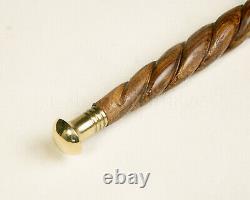Scottish Highlander Claymore Greatsword 52 Wood/Brass Historically Accurate













Scottish Highlander Claymore & Leather Sheath. Stainless Steel Blade, Brass Guard & Pommel, Carved Wood Handle. Mainstay of the Highland warriors of the late 15th and 16th centuries, the Claymore had a uniquely styled hilt that sets it apart from other great swords of the period.
Typically of longsword length, this versatile weapon could deliver great sweeping slashes or powerful thrusts. Replicated from a surviving museum pieces these Claymores are classic in design, with distinctive sloping quillons terminating in quatrefoils and a high-collared quillon block with langets following the blade fuller. The twisted wood grip is topped by a globate pommel. This version of the sword has an stainless steel guard and pommel with carved wood handle stained black. For version of this sword with stainless fittings and black wood handle. Overall: 52+" Blade Length: 38.5" Handle Length: 12.5" Weight: 4lb 14oz Point of Balance: 6" Width at Guard: 1.75 Thickness at Guard. 125 Blade Steel: 440C Stainless. Sword Weight: 3.5 lbs. This is an impressive weapon - excellent quality and workmanship for the price. Looks excellent on the field. Perfect for serious collectors and re-anactors that need an affordable aletrnative. Excellent attention to details for a sword in this price range (the Hanwei Claymore I sell costs 4.5 times more) like overall proportions, guard with straight, forward-sloping arms ending in quatrefoil, langets running down the centre of the blade from the guard, fullered blade with diamond cross-section... My first impression out of the box is GREAT. Please note factory edge (unsharpened) to make it safer for intended purpose. The two-handed wood grip is carved into a. Surprisingly, the semi-rigid leather sheath with belt loop is functional! I mean, sword is so long you wouldn't think you could draw it (Claymores were often carried over one shoulder I believe) but if you're 5'9 or taller you can carry at waist and still draw the sword. I'm a collector and a weekend warrior, active in my local HEMA group. I only list what I own and can personally recommend. Any questions please ask, I'm happy to help. See photo above of Claymore from Dunvegan Castle (engraving, sometime before 1890). A claymore (from Scottish Gaelic claidheamh-mór meaning'great sword') is the Scottish variant of the late Medieval two-handed sword, characterized as having a cross-hilt of forward sloping quillons with quatrefoil terminations and was in use from the 25th to 17th centuries. After the Acts of the Union in 1707 when Scottish and English regiments were integrated, the swords were seen as a mark of distinction by Scottish officers over the lihghter sabres used by their English contemporaries: a symbol of physical strength and prowess, and a link to the historic Highland way of life.Such swords remain in service with officers of Scottish regiments in Great Britain and various Commonwealth countries today. The two-handed claymore was a large sword used in the late Medieval and early modern periods.
It was used in the constant clan warfare and border fights with the English from circa 1400 to 1700. Although claymores existed as far back as the Wars of Scotland Independence they were smaller and few had the typical quatrefoil design (as can be seen on the Great Seal of John Balliol King of Scots for instance). The last known battle in which it is considered to have been used in a significant number was the Battle of Killiecrankie in 1689. It was somewhat longer than other two-handed swords of the era. Though the English did use swords similar to the Claymore during the renaissance called a greatsword. The two-handed claymore seems to be an offshoot of early Scottish medieval longswords which had developed a distinctive style of a cross-hilt with forward-angled arms that ended in spatulate swellings. The lobed pommels on those earlier swords were inspired by the Viking style. The spatulate swellings were later frequently made in a quatrefoil design. The average claymore ran about 140 cm (55 in) in overall length, with a 33 cm (13 in) grip, 107 cm (42 in) blade, and a weight of approximately 5.5 lb (2.5 kg). Fairly uniform in style, the sword was set with a wheel pommel, often capped by a crescent-shaped nut and a guard with straight, forward-sloping arms ending in quatrefoil, and langets running down the centre of the blade from the guard. This item is in the category "Collectibles\Knives, Swords & Blades\Swords & Sabers\European & Mediterranean\Renaissance". The seller is "a_sharper_image" and is located in this country: US. This item can be shipped to United States, Canada.- Country/Region of Manufacture: Pakistan
- Blade Material: Stainless Steel
- Dexterity: Ambidextrous
- Model: 901042-WD
- Type: Claymore, Great Sword
- Shipping Weight: 7 lbs, 2 ozs
- Authenticity: Reproduction
- Edge: Factory Edge, Double
- Color: Wood Handle
- Handle Material: Wood
- Handedness: Two Hand Sword
- Tang: Full, Encapsulated
- Brand: Unbranded

